INSTITUT SUPERIEUR D'ANTHROPOLOGIE
INSTITUTE OF ANTHROPOLOGY
ONLINE COURSES / COURS A DISTANCE
SPRING SESSION : APRIL 2013
REGISTER NOW !
FRANCE – 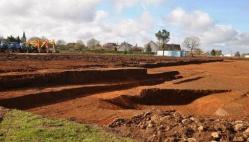 Buxerolles - Avant de devenir un lotissement, le site de la Grande sablière étale son passé. En novembre, un diagnostic des lieux commandé par la DRAC Poitou-Charentes a révélé des traces de présence humaine anciennes. Depuis un mois, l'institut national de recherches archéologiques préventives y effectue un chantier de fouilles. Préalable nécessaire aux recherches, durant trois semaines, dix-mille mètres cubes de terre ont été dégagés pour le décapage du terrain. Après le retrait de la couche superficielle, la mise à nu révèle bon nombre d'anomalies caractérisées par des couleurs différentes sur le sol argileux. Responsable du chantier, Marie-Luce Merleau dirige les travaux menés par l'équipe de huit archéologues de l'Inrap. « Nous repérons et marquons toutes les anomalies visibles sur le sol avant d'en faire un relevé topographique. Environ trois cent cinquante particularités sont recensées mais elles ne sont pas forcément la conséquence d'activités humaines, des animaux comme les taupes ou les lapins peuvent avoir modifié certains éléments. Il nous faut maintenant les caractériser par la fouille méthodique et l'analyse des matériaux recueillis. Sur le relevé topographique, il semble que le site soit traversé par un fossé, on y voit également des traces de plantation de poteaux, c'est peut-être le signe d'une présence de l'homme au néolithique (entre 5000 et 2100 ans avant notre ère). Quelques rares fragments de céramiques indiqueraient une occupation à l'époque médiévale. Nos travaux vont essayer d'établir à quelles périodes il y eu de la présence humaine et quelles activités ont été menées sur la grande sablière. Notre activité va être menée jusqu'au début de juin. »
Buxerolles - Avant de devenir un lotissement, le site de la Grande sablière étale son passé. En novembre, un diagnostic des lieux commandé par la DRAC Poitou-Charentes a révélé des traces de présence humaine anciennes. Depuis un mois, l'institut national de recherches archéologiques préventives y effectue un chantier de fouilles. Préalable nécessaire aux recherches, durant trois semaines, dix-mille mètres cubes de terre ont été dégagés pour le décapage du terrain. Après le retrait de la couche superficielle, la mise à nu révèle bon nombre d'anomalies caractérisées par des couleurs différentes sur le sol argileux. Responsable du chantier, Marie-Luce Merleau dirige les travaux menés par l'équipe de huit archéologues de l'Inrap. « Nous repérons et marquons toutes les anomalies visibles sur le sol avant d'en faire un relevé topographique. Environ trois cent cinquante particularités sont recensées mais elles ne sont pas forcément la conséquence d'activités humaines, des animaux comme les taupes ou les lapins peuvent avoir modifié certains éléments. Il nous faut maintenant les caractériser par la fouille méthodique et l'analyse des matériaux recueillis. Sur le relevé topographique, il semble que le site soit traversé par un fossé, on y voit également des traces de plantation de poteaux, c'est peut-être le signe d'une présence de l'homme au néolithique (entre 5000 et 2100 ans avant notre ère). Quelques rares fragments de céramiques indiqueraient une occupation à l'époque médiévale. Nos travaux vont essayer d'établir à quelles périodes il y eu de la présence humaine et quelles activités ont été menées sur la grande sablière. Notre activité va être menée jusqu'au début de juin. »
http://www.lanouvellerepublique.fr/Vienne/communes/Buxerolles/n/Contenus/Articles/2013/04/18/La-longue-histoire-de-la-Grande-sabliere-1415900
INDE – 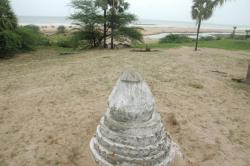 Kanaparthi - A Rama temple replete with history in this coastal village, covered by sand dunes, will vanish from public view forever unless urgent steps are taken to protect it. Located some 100 to 150 metres from the sea tide level, only the temple tower is visible now. The sleepy village is full of artefacts of both pre-historic and historic periods throwing light on the rich culture of the Andhra Pradesh people down the ages. “The temple seems to belong to the period of Chalukyas or Telugu Cholas and calls for a detailed study,” said State Archaeology and Museums in-charge Director G.V. Ramakrishna Rao told The Hindu. The museum in the village with a wonderful collection of stone inscriptions in Prakrit and Brahmi and other artefacts would be expanded and renovated to showcase the political, socio-economic and cultural aspects of the life of Andhra people for several centuries, Mr. Rao added. The archaeological evidence found in and around Kanaparthi show that it was a flourishing centre of Buddhism and also Jainism and could be put on the international tourism circuit, felt social activist Komatla Trinatha Reddy, national Gram Ratan awardee.
Kanaparthi - A Rama temple replete with history in this coastal village, covered by sand dunes, will vanish from public view forever unless urgent steps are taken to protect it. Located some 100 to 150 metres from the sea tide level, only the temple tower is visible now. The sleepy village is full of artefacts of both pre-historic and historic periods throwing light on the rich culture of the Andhra Pradesh people down the ages. “The temple seems to belong to the period of Chalukyas or Telugu Cholas and calls for a detailed study,” said State Archaeology and Museums in-charge Director G.V. Ramakrishna Rao told The Hindu. The museum in the village with a wonderful collection of stone inscriptions in Prakrit and Brahmi and other artefacts would be expanded and renovated to showcase the political, socio-economic and cultural aspects of the life of Andhra people for several centuries, Mr. Rao added. The archaeological evidence found in and around Kanaparthi show that it was a flourishing centre of Buddhism and also Jainism and could be put on the international tourism circuit, felt social activist Komatla Trinatha Reddy, national Gram Ratan awardee.
http://www.thehindu.com/features/friday-review/history-and-culture/historic-rama-temple-cries-for-attention/article4627933.ece
CAMBODGE – 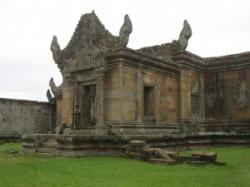 - Preah Vihear - The United Nations highest court today began new hearings on a spectacularly situated 900-year-old Hindu temple that has long been a bone of contention between Cambodia and Thailand and has in recent years led to deadly clashes between the two South-East Asian neighbours. Nearly two years ago, the Hague-based International Court of Justice (ICJ) ordered the two countries to withdraw their military personnel from around the Preah Vihear temple complex located in Cambodia, after renewed fatal skirmishes forced thousands of people to flee. The site is inscribed on the World Heritage List which is drawn up by the UN Educational, Scientific and Cultural Organization (UNESCO). In inscribing it, UNESCO called the temple “an outstanding masterpiece of Khmer architecture, in terms of plan, decoration and relationship to the spectacular landscape environment” atop a 1,772-foot cliff.
- Preah Vihear - The United Nations highest court today began new hearings on a spectacularly situated 900-year-old Hindu temple that has long been a bone of contention between Cambodia and Thailand and has in recent years led to deadly clashes between the two South-East Asian neighbours. Nearly two years ago, the Hague-based International Court of Justice (ICJ) ordered the two countries to withdraw their military personnel from around the Preah Vihear temple complex located in Cambodia, after renewed fatal skirmishes forced thousands of people to flee. The site is inscribed on the World Heritage List which is drawn up by the UN Educational, Scientific and Cultural Organization (UNESCO). In inscribing it, UNESCO called the temple “an outstanding masterpiece of Khmer architecture, in terms of plan, decoration and relationship to the spectacular landscape environment” atop a 1,772-foot cliff.
http://www.southeastasianarchaeology.com/2013/04/18/thailand-cambodia-argue-preah-vihear-in-front-of-icj/
FRANCE – 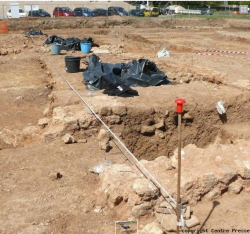 Poitiers - En débutant cette nouvelle campagne de fouilles à l'emplacement de l'ancien hôpital Pasteur, les archéologues de l'Inrap savent qu'ils remonteront le temps jusqu'aux premiers siècles de notre ère. Par le passé, notamment au XIX siècle et beaucoup plus récemment en 2009, des fouilles ont déjà eu lieu sur le site, révélant des thermes romains (appartenant peut-être à une villa), des vestiges de constructions et une zone de culture, toujours de l'époque antique. Même s'ils en sont encore au tout début des recherches (les fouilles ont débuté le 2 avril et dureront jusqu'au 31 mai), les archéologues ont déjà mis au jour des éléments venant enrichir la connaissance de cette zone, à l'emplacement géographique particulièrement intéressant. Frédéric Gerber, responsable de l'opération pour l'Inrap, explique: « C'est un site privilégié, entre les routes de Limoges (rue du faubourg du Pont-Neuf) et de Bourges (rue du faubourg Saint-Cyprien). C'est l'un des rares endroits où la falaise est en retrait, au bord du Clain, qui était une voie de navigation. Nous voulons savoir à quoi était vouée cette zone, qui est la seule connue d'occupation antique d'importance de ce côté du Clain. On cherche aussi une occupation plus ancienne: nous avons des charbons de bois ou des silex qui indiquent une fréquentation préhistorique. » Les niveaux de sols dégagés permettent de penser qu'à l'Antiquité, le site était aménagé en terrasses: « Les premières constructions datent de la fin du I siècle. On n'a pas encore de plan précis mais il semble que toute la zone ait été bâtie, avec des niveaux de sols contemporains qui sont en décalage régulier, de 30 cm environ. » Frédéric Gerber ajoute: « Il y a eu un incendie, probablement au II siècle (lire ci-contre). De nouveaux bâtiments, qui ont l'air plus grands, ont été reconstruits, mais on n'en saura peut-être pas plus car ces murs ont été très arasés, peut-être au moment de l'implantation de l'abbaye au Moyen Age. » En effet, plus aucune occupation n'est attestée après le IV siècle, jusqu'au moment où a été créée l'abbaye Saint-Cyprien au IX siècle. L'espace actuellement fouillé serait même resté une zone de culture jusqu'à la construction de l'hôpital Pasteur au XX.
Poitiers - En débutant cette nouvelle campagne de fouilles à l'emplacement de l'ancien hôpital Pasteur, les archéologues de l'Inrap savent qu'ils remonteront le temps jusqu'aux premiers siècles de notre ère. Par le passé, notamment au XIX siècle et beaucoup plus récemment en 2009, des fouilles ont déjà eu lieu sur le site, révélant des thermes romains (appartenant peut-être à une villa), des vestiges de constructions et une zone de culture, toujours de l'époque antique. Même s'ils en sont encore au tout début des recherches (les fouilles ont débuté le 2 avril et dureront jusqu'au 31 mai), les archéologues ont déjà mis au jour des éléments venant enrichir la connaissance de cette zone, à l'emplacement géographique particulièrement intéressant. Frédéric Gerber, responsable de l'opération pour l'Inrap, explique: « C'est un site privilégié, entre les routes de Limoges (rue du faubourg du Pont-Neuf) et de Bourges (rue du faubourg Saint-Cyprien). C'est l'un des rares endroits où la falaise est en retrait, au bord du Clain, qui était une voie de navigation. Nous voulons savoir à quoi était vouée cette zone, qui est la seule connue d'occupation antique d'importance de ce côté du Clain. On cherche aussi une occupation plus ancienne: nous avons des charbons de bois ou des silex qui indiquent une fréquentation préhistorique. » Les niveaux de sols dégagés permettent de penser qu'à l'Antiquité, le site était aménagé en terrasses: « Les premières constructions datent de la fin du I siècle. On n'a pas encore de plan précis mais il semble que toute la zone ait été bâtie, avec des niveaux de sols contemporains qui sont en décalage régulier, de 30 cm environ. » Frédéric Gerber ajoute: « Il y a eu un incendie, probablement au II siècle (lire ci-contre). De nouveaux bâtiments, qui ont l'air plus grands, ont été reconstruits, mais on n'en saura peut-être pas plus car ces murs ont été très arasés, peut-être au moment de l'implantation de l'abbaye au Moyen Age. » En effet, plus aucune occupation n'est attestée après le IV siècle, jusqu'au moment où a été créée l'abbaye Saint-Cyprien au IX siècle. L'espace actuellement fouillé serait même resté une zone de culture jusqu'à la construction de l'hôpital Pasteur au XX.
http://www.centre-presse.fr/article-234556-des-batiments-du-i-siecle-sur-le-site-de-pasteur.html
ROYAUME UNI – 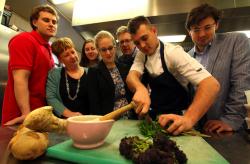 Durham - A 12th-century manuscript contains the oldest known European Medieval food recipes, according to new research. The recipes, which include both food and medical ointment concoctions, were compiled and written in Latin. Someone jotted them down at Durham Cathedral’s monastery in the year 1140. It was essentially a health book, so the meals were meant to improve a person’s health or to cure certain afflictions. The other earliest known such recipes dated to 1290. Faith Wallis, an expert in medical history and science based at McGill University, translated a few for Discovery News: “For “hen in winter’: heat garlic, pepper and sage with water.” “For ‘tiny little fish’: juice of coriander and garlic, mixed with pepper and garlic.” For preserved ginger, it should kept in “pure water” and then “sliced lengthwise into very thin slices, and mixed thoroughly with prepared honey that has been cooked down to a sticky thickness and skimmed. It should be rubbed well in the honey with the hands, and left a whole day and night.” Re – the “hen in winter” dish, Giles Gasper from Durham University’s Institute of Medieval and Early Modern Studies said, “We believe this recipe is simply a seasonal variation, using ingredients available in the colder months and specifying ‘hen’ rather than ‘chicken,’ meaning it was an older bird as it would be by that time of year.” Gasper added, “The sauces typically feature parsley, sage, pepper, garlic, mustard and coriander, which I suspect may give them a Mediterranean feel when we recreate them. According to the text, one of the recipes comes from the Poitou region of what is now modern central western France. This shows the extent to which international travel and exchange of ideas took place within the medieval period. And what more evocative example of cultural exchange could there be than food?”
Durham - A 12th-century manuscript contains the oldest known European Medieval food recipes, according to new research. The recipes, which include both food and medical ointment concoctions, were compiled and written in Latin. Someone jotted them down at Durham Cathedral’s monastery in the year 1140. It was essentially a health book, so the meals were meant to improve a person’s health or to cure certain afflictions. The other earliest known such recipes dated to 1290. Faith Wallis, an expert in medical history and science based at McGill University, translated a few for Discovery News: “For “hen in winter’: heat garlic, pepper and sage with water.” “For ‘tiny little fish’: juice of coriander and garlic, mixed with pepper and garlic.” For preserved ginger, it should kept in “pure water” and then “sliced lengthwise into very thin slices, and mixed thoroughly with prepared honey that has been cooked down to a sticky thickness and skimmed. It should be rubbed well in the honey with the hands, and left a whole day and night.” Re – the “hen in winter” dish, Giles Gasper from Durham University’s Institute of Medieval and Early Modern Studies said, “We believe this recipe is simply a seasonal variation, using ingredients available in the colder months and specifying ‘hen’ rather than ‘chicken,’ meaning it was an older bird as it would be by that time of year.” Gasper added, “The sauces typically feature parsley, sage, pepper, garlic, mustard and coriander, which I suspect may give them a Mediterranean feel when we recreate them. According to the text, one of the recipes comes from the Poitou region of what is now modern central western France. This shows the extent to which international travel and exchange of ideas took place within the medieval period. And what more evocative example of cultural exchange could there be than food?”
http://news.discovery.com/history/oldest-european-medieval-cookbook-found-130417.htm